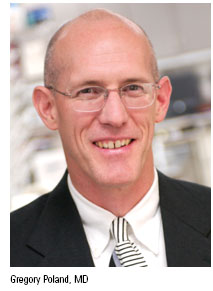Physician speaks on agroterrorism, bioterrorism
|
By Allison Clark "I'm very interested in what I'm going to call the merging of two issues: human medicine and animal medicine," said Gregory Poland, MD, during his session at the AVMA Annual Convention in July. "I'm very interested in the fact that we've made a terrible mistake in this country, and that is, we never talk."
"What most physicians think about veterinarians is as the guy or gal on the corner who treats fleas. ... I was shocked to find you guys are more advanced than we are in many respects, and we don't know it," Dr. Poland continued. "I realized you also much more rapidly, in the animal field, develop vaccines compared to human (medicine)." Dr. Poland serves as director at the Rochester, Minn.-based Mayo Clinic's Vaccine Research Group, which investigates vaccine response issues and novel vaccines important to public health. During his session, Dr. Poland explained some of the perceived vulnerabilities to agroterrorism in the United States. First, the nation centralizes the production and processing of its food supply. For example, 53 percent of hogs in the United States are produced in three states, Dr. Poland said, making it easier to quickly infect livestock. Next, a large percentage of U.S. food is purchased from other countries, leading to cross-country contamination. So what would it cost the nation if an agroterrorism attack occurred? American agriculture generates more than $1 trillion per year, not to mention an abundant food supply for Americans and others, according to a Government Accountability Office report. The report examined the role of certain federal agencies in protecting the United States against agroterrorism. Events in other countries could serve as examples of agroterrorism's economic impact. Taiwan experienced a foot-and-mouth disease outbreak in 1997 that cost the country $20 billion and the United Kingdom in 2001 encountered a foot and mouth disease outbreak that cost $48 billion, Dr. Poland said. Avian influenza and Newcastle disease outbreaks have also had an economic impact on select countries. Dr. Poland explained how U.S. veterinarians could better prepare themselves for an attack: education. The GAO reported that 26 percent of the nation's veterinary graduates have taken a course specifically dedicated to foreign animal diseases. Meanwhile, foreign animal disease training is not required for Department of Agriculture-accredited veterinarians, the ones most likely to be called upon if livestock were attacked, according to GAO. Two years ago, the USDA drafted a rule to make such training a prerequisite for accreditation, but other draft rules have taken precedence and caused the change to be delayed. "How many veterinary schools are at universities that also have human medical schools," Dr. Poland asked the audience. By adjusting the curriculum at both colleges, he believes there will be more opportunity for collaboration between the veterinary and human medical communities. Along with agroterrorism, Dr. Poland discussed the threat of bioterrorism, specifically anthrax and smallpox. Biologic terrorism is more likely than ever before, he said, and completely preventing or countering bioterrorism in the United States is not currently possible. Anthrax and smallpox are two bioweapons of choice, he said, because they are highly lethal, stable for transmission in aerosol form, and amenable to large-scale production. They're also odorless and tasteless, and there are limited vaccines available. During his presentation, Dr. Poland said veterinarians could be affected by bioterrorism agents through direct attack, bystander exposure, and environmental contamination. To prove how at risk the United States is to bioterrorism, he reviewed the Iraqi and Russian bioweapons programs and the Soviet biowarfare program. To encourage more communication about agroterrorism and bioterrorism between the veterinary and medical communities, Dr. Poland referred back to a change in curriculums and suggested veterinarians host more meetings on the topic, such as the one at the AVMA convention. | ||
 As a physician addressing a room full of veterinarians, Dr. Poland stressed the need for the veterinary and human medical communities to communicate more effectively when it comes to agroterrorism and bioterrorism. He believes physicians and veterinarians should work together to understand threats and develop vaccines and therapeutics.
As a physician addressing a room full of veterinarians, Dr. Poland stressed the need for the veterinary and human medical communities to communicate more effectively when it comes to agroterrorism and bioterrorism. He believes physicians and veterinarians should work together to understand threats and develop vaccines and therapeutics.